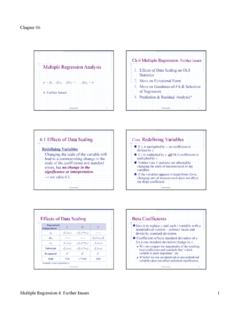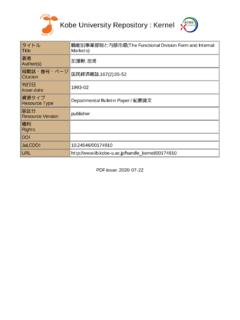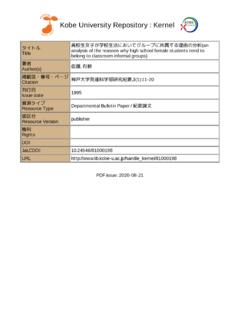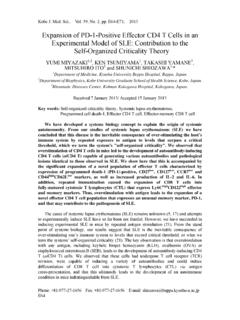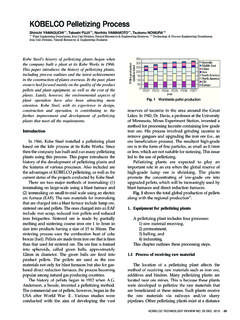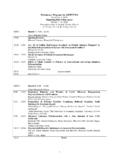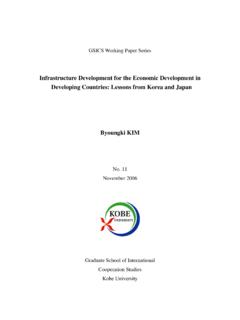Transcription of An Overview of the Antimonopoly Act in Japan
1 An Overview of the Antimonopoly Act in JapanFumio SensuiProfessor at the Graduate School of Law, kobe Universitysensui2015(at) The figures and data in the following materials are cited from the Annual Reports, etc. published by the Japan Fair Trade Commission (JFTC).2 Acts prohibited under the Antimonopoly Act in Japan Prohibition of private monopolization Prohibition of unreasonable restraint of trade Regulation of mergers Prohibition of unfair trade practices3 Execution of the Antimonopoly Act The Antimonopoly Act is administered and executed by the Japan Fair Trade Commission (JFTC). The JFTC belongs to the Cabinet Office, and does not belong to a specific regulatory agency. It is an independent regulatory commission. The JFTC takes administrative dispositions (Cease and desist orders and Surcharge payment orders). Any entrepreneur who is the addressee of an order may file a revocation suit in the Tokyo District Court if having a complaint.
2 Although there existed a hearing procedure as an internal procedure of the JFTC, which enabled a complaint against the decision made by the JFTC to be filed in the Tokyo High Court until the Antimonopoly Act was amended in 2013, the hearing system was abolished (the amended law came into force in April 2015).4 Execution of the Antimonopoly Act Criminal punishment: It is judged by a court after accusation by the JFTC and indictment by the Prosecutor-General Civil claim: Although there are some provisions on this in the Antimonopoly Act, it is usually judged by a court after a claim for damages is made by an injured party based on the Civil Code, of private monopolization Contents of the act: private monopolization Clause: The term private monopolization as used in this Act means such business activities by which any entrepreneur, individually or in combination or conspiracy with other entrepreneurs, or in any other manner, excludes or controls the business activities of other entrepreneurs, thereby causing, contrary to the public interest, a substantial restraint of competition in any particular field of trade.
3 (Article 2 (5))6 Example of private monopolization NTT East case (Supreme Court Decision in 2011) NTT East s act was judged to be private monopolization: NTT East provided an optical fiber connection service by setting the user charge at a price (monthly, 5,800 yen to 4,500 yen per month) lower than the connection charge (monthly, 6,328 yen) that other telecommunication companies had to pay to provide the same service by connecting to NTT East s optical fiber equipment. Although there was no surcharge system against private monopolization at that time, a surcharge will be imposed if a similar case occurs now. A substantial restraint of competition means the formation, maintenance, or strengthening of the market power. 7 Prohibition of the unreasonable restraint of trade Contents of the acts: price-fixing agreements (price-fixing cartels), quantity-limiting agreements, bid rigging, market share cartels, purchase cartels, customer-limiting cartels, activities of trade associations Clause: The term unreasonable restraint of trade as used in this Act means such business activities by which an entrepreneur, through a contract, agreement or any other means irrespective of its name, in concert with other entrepreneurs mutually restrict or conduct their business activities in such a manner as to fix, maintain or increase prices, or to limit production, technology, products, facilities or counterparties, thereby causing, contrary to the public interest, a substantial restraint of competition in any particular field of trade.
4 (Article 2 (6))8 Example of the unreasonable restraint of trade Refuse incinerator bid rigging case (cease and desist order and surcharge payment order) A cease and desist order was issued to five refuse incinerator manufacturers that in concert determined the prospective successful bidder so that the bidder could contract the construction of continuous and semi-continuous furnaces ordered by local governments. Subsequently, a surcharge payment order was issued under the former law. The total amount of the surcharge imposed on the five companies was about 27 billion yen. The local governments then claimed for damages, resulting in many court decisions. The competent courts awarded damages of about billion yen in a case in kobe City, 530 million yen in a case in Amagasaki City, and about billion yen in a case in Kyoto of the unreasonable restraint of trade (international case) Cathode-ray tube cartel case (cease and desist order and surcharge payment order in 2009, decision made by the JFTC on May 22, 2015) Eleven Asian cathode-ray tube manufacturers agreed on the selling prices of cathode-ray tubes for televisions.
5 Of the eleven manufacturers, the JFTC issued cease and desist orders to two companies and issued surcharge payment orders to five other companies ( billion yen in total). The amount of the surcharge was calculated based on the sales of cathode-ray tubes purchased by the local subsidiaries of Japanese cathode-ray tube television manufacturers located in other Asian countries. JFTC served written surcharge payment orders to attorneys living in Japan . With regard to the manufacturers that the JFTC could not serve orders, the JFTC issued a cease and desist order to a manufacturer and surcharge payment orders to two companies by service and by publication. The decision concluded that surcharge payment order, etc. was concluded that the Japanese companies manufacturing and selling cathode-ray tube televisions had decided important business conditions, such as negotiations, suppliers, purchase prices, and purchase quantities, and instructed the local subsidiaries to purchase; the Japanese companies manufacturing and selling cathode-ray tube televisions were deemed to be the consumers of the cathode-ray tubes in question, and the competition in the sales field of said cathode-ray tubes was considered to exist mainly over consumers located in of mergers Contents of the acts; mergers, share holding, business transfers, corporate separation, etc.
6 Clause (merger): No company shall effect a merger if any of the following items applies: (i) When the effect of the merger may be to substantially restrain competition in a particular field of trade (Article 15)11 Example of merger regulation Panasonic-Sanyo merger case (2009) Panasonic, which manufactures and sells electrical equipment, considered making Sanyo Electric its subsidiary by acquiring a majority of the voting rights of the shares of Sanyo. A remedy (problem-solving measure) was taken that is, the Tottori plant for producing cylindrical manganese dioxide lithium batteries (for residential fire-alarm device) was transferred to a rival. It was judged that there was no problem concerning lithium-ion secondary batteries (for consumer use) and nickel hydride batteries (for automobiles). This case was filed for examination in many countries throughout the world (such as the US, EU, and China).
7 As a result of an examination in China, a business transfer as an additional remedy was demanded concerning nickel hydride batteries (for automobiles).12 Prohibition of unfair trade practices Contents of the acts: concerted refusal to trade, individual refusal to trade, discriminatory pricing, unjust low price sales, unjust customer inducements, tie-in sales, dealing with restrictive conditions, dealing with exclusive conditions, resale price maintenance, abuse of a superior bargaining position, interference with a competitor's transactions Clause: The term unfair trade practices as used in this Act means any act falling under any of the following items .. (the rest is omitted) (Article 2 (9))13 Examples of unfair trade practices Although there are various acts, the following are examples of the abuse of a superior bargaining position, which is frequently detected recently: In 2009, the surcharge system was introduced for the abuse of a superior bargaining position.
8 EDION case (cease and desist order and surcharge payment order in 2012): An order to pay a surcharge of 4, million yen was issued to EDION, a mass retailer of electrical home appliances, which had suppliers dispatch employees without concluding any agreement on the conditions for the dispatch of these employees to take out, bring in, or set up appliances in the shop and without paying the expenses that are usually necessary for such dispatch. Regarding acts that the headquarters of the supermarkets conducted toward the suppliers, an order to pay a surcharge of million yen was issued to Sanyo Marunaka in 2011, and an order to pay a surcharge of about billion yen was issued to RALSE in 2013. A decision was made for the first time since the introduction of the surcharge system in 2009 (Toys R Uscase, March 26, 2015).The decision concluded that abuse of a superior bargaining position did not apply to part of the conduct and annulled a part of the surcharge payment order (the amount beyond million yen ( million yen) out of the total amount of million yen).
9 14 Characteristics of the Antimonopoly Act in Japan (1) See the attached materials (table). This was enacted in 1947. It was the third competition law in the world after those in the US and Canada. Although it was modeled on the US law, it has many original provisions. It regulates not the abuse of a dominant market position, but private monopolization (influence of the US law). Regarding hardcore cartels (price cartels, bid rigging, etc.), the requirements also include a particular field of trade (relevant market) and substantial restraint of competition (however, depending on the legal interpretation, they are quasi per se illegal in reality). Due to the influence of precedents, etc., vertical restraints are substantially regulated not as an unreasonable restraint of trade but as an unfair trade of the Antimonopoly Act in Japan (2) Unfair trade practices have been regulated frequently.
10 The regulation of these is stricter than for private monopolization. Regulation of unfair trade practices has been influenced by the US law. However, the regulation of unfair trade practices in Japan is stricter than in the US ( substantial restraint of competition as an effect requirement for private monopolization that is, the formation, maintenance, or strengthening of market power is unnecessary; it is sufficient to prove that an act tends to impede fair competition ). The provision for the abuse of a superior bargaining position is not included in the competition laws of many foreign countries. The execution of this provision has been strengthened by the introduction of the surcharge system in 2009. Japan has a Subcontracts Act as a special law for restriction of the abuse of a superior bargaining position, which has been frequently used to restrict such abuse.







